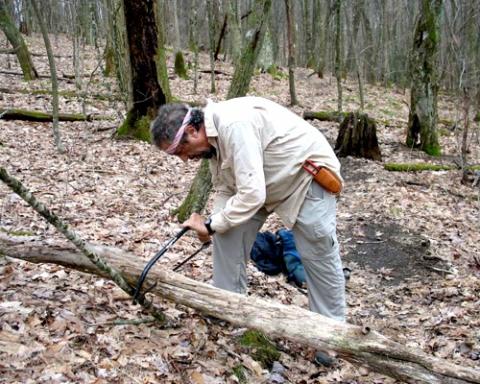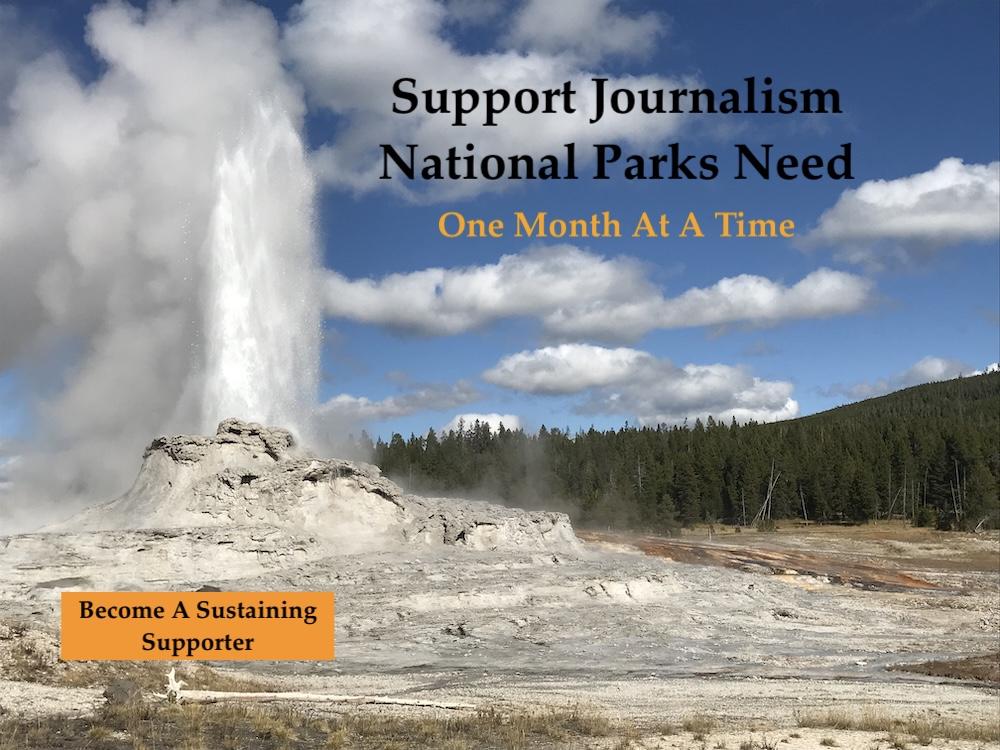My husband, Lenny, and I have been maintaining a section of the Appalachian National Scenic Trail for more than 20 years, first in New York State and now on the border of North Carolina and Tennessee.
For the last eight years, we’ve been the proud adoptive parents of 4.9 miles from Devils Fork Gap to Rice Gap located north of Great Smoky Mountains National Park and south of Hot Springs, North Carolina. It’s not a spectacular piece of trail – no historic cabin, shelter, or outstanding view.
But this plain duckling has some unusual features. It wiggles compass south when you hike A.T. north. In May, the trail explodes with wildflowers; I’ve counted over 45 species and I’m hardly an expert. There’s plenty of evidence that people lived here before it became part of Cherokee National Forest, including a two-grave cemetery and barbed wire fences for cattle. It has remains of two cabins that have been taken apart. Its logs have tumbled down over white metal kitchen cabinets. Last year, we took out a white toilet. A nameless waterfall has a large log across it, guaranteeing that its photo will never grace the pages of an outdoor calendar.
For trail maintenance, it's considered a long piece to maintain, though it doesn’t seem like much when we hike it. At least four times a year, we drive two cars and put a car at each end. We don’t want to walk our section twice, loaded down with a weed eater, clippers, sheers, hand saws, and garbage bags. We only haul out garbage, and there's not much of that. Clippings and branches get thrown off the trail. I take great pleasure in breaking up campfire rings that have been illegally built right on the trail.
My hiking club, the Carolina Mountain Club, maintains 92 miles of the A.T., including nine shelters. The club takes its trail maintenance responsibilities seriously. Though we’re considered a small club (only about 1,000 members), we treat trail maintenance like a large company. Lenny and I are among those who do the grunt work; we clip brush, clean water bars, pick up garbage, and take out small blowdowns. We also paint blazes using glossy white exterior paint; the can says its paint is guaranteed for 25 years, but we have to refresh the blazes every few years.
The entire A.T. from Maine to Georgia is maintained by volunteers belonging to one of 30 trail-maintaining clubs. The National Park Service delegated management responsibility for lands acquired by NPS along the Appalachian Trail to the Appalachian Trail Conservancy. The ATC, for itself and in behalf of the trail-maintaining clubs, accepted responsibility for operations, development, maintenance, and monitoring of those trail-corridor lands.
Though the A.T., a unit of the National Park System, is maintained by volunteers, the land that the trail goes through is managed by the governmental body that owns the land, usually the specific national park or national forest. Our section of the A.T. goes through Cherokee National Forest. When their biologists want to create a clearcut for wildlife management or need to burn a section, they might discuss it with the A.T.C., but then they go ahead and do what they need to do.
Spring Work Assignments
Spring has finally arrived and we received our first instructions from Don Walton, our A.T. coordinator: "It's time to do the spring walk-thru, clean water bars and report problems on your A.T. section. We know that we have many downed trees. So, your input is going to be valuable for the crews to coordinate removal of trees. So get out there because the thru-hikers are coming.”
When we encounter a downed tree too big for our Silky saw, a hand-saw with a long handle, we call in the reinforcements, the CMC trail crew that wields chain saws. CMC crews go out Mondays, Wednesdays, and Fridays year-round to do the heavy trail work. Most of these guys -- and they’re mostly guys -- are way past retirement age – their average age is 70. They worked behind a desk for decades and now they want to build things.
Bears have been active, prowling around several A.T. shelters, so Howard McDonald, our trail facility manager, put a volunteer crew together to install bear cables, similar to the ones in the Smokies.
“We received a grant from North Carolina A.T. license plate money to cover the costs of equipment," he explains. "Frustrated bears and hikers playing Tarzan have caused some damage, but we’re fixing them and strengthening them to prevent this from happening again. We have a very good system that the hikers like and will last for many years.”
By early summer, blackberry cane can overwhelm the trail. Since we live in a temperate rainforest, we can’t leave a trail alone or in a couple of years it would be so overgrown that we wouldn’t find it again - we need to keep the growth in check. Blackberry bushes might be easy to grow in a garden because the plant doesn't demand much sunlight or good soil. Those qualities make the same plant a nuisance on the trail. By July, the stems or canes, as they're called, project their thorny lateral branches into the trail.
In the Southern Appalachians, poison ivy also grows like it's on steroids. But there's none on our section of the A.T. and for that, I'm grateful.
Adopting a trail is like adopting a highway. You get your own piece of real estate with magnificent views. You don’t have to have great experience or powerful tools. You’re the eyes and ears of the trail. You do what you can and report what you can’t do. You work at your own pace.
In our hiking club, adopting a piece of the A.T. is quite prestigious. If a trail maintainer gives up their piece of trail, it is snapped up almost immediately by another member on the waiting list. But this is not episodic volunteering - we don't have a club-wide trail maintaining day, followed by a barbecue and a band. Rather, section maintainers, as we are called, usually work on their own, tending the same piece of trail for years.
I don’t particularly enjoy trail maintenance; I’d rather be hiking. Maintaining is slow and tedious. By evening, my back is usually stiff and sore; I sleep on the floor and maybe take a couple of aspirins. But I do it because it’s part of my hiking life. I don’t like cleaning my boots either, but that’s also part of hiking.
For all this work, I get my reward when I meet hikers on our section. I stop them long enough to introduce myself. “Trails don’t maintain themselves,” I tell them. “Volunteers maintain trails. That’s how the whole A.T. gets taken care of.”
In exchange for listening to me, I volunteer to take out their garbage. They’re surprised; their usual trail magic is another piece of chocolate or granola bar. But I remember when I hiked the A.T. that getting rid of trash was the most annoying part of the trail routine.


 Support Essential Coverage of Essential Places
Support Essential Coverage of Essential Places







Comments
Great article and even better trail work! I love trail maintainers and enjoy saying "THANKS" whenever I meet them on my section hikes. I'm too far away to maintain the AT, but I do volunteer locally to help maintain local trails and parks. It takes us all doing our small (or big) parts. Thank you two, Danny and Lennie!
Danny and Lennie -
THANK YOU - we thru-hikers couldn't live out our lifelong dreams without the tireless hard work of you and your fellow maintainers & it is much apprecialted.
I have been a volunteer for the ATC for about 5 years. We just worked on the trail on Bear Mountain New York, it will open on Trail Day this year. I hope to see yaw there. It is a wonderful job. I also worked in PA, VA, NY.
Thank you so much for the good you do. In 2001, I had trail magic show up in a lot of differnt ways. The unsing heroes are the ones I never met, who kept the trail clear for me to pass on thru...God Bless and Peace to you and yours.
Kingfish 2001